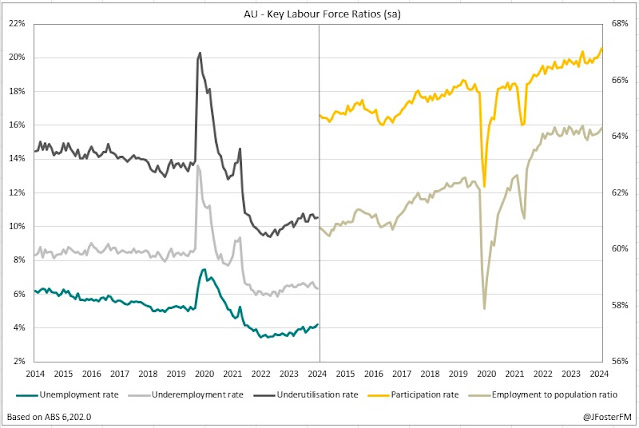A raft of stimulus measures from the authorities to support economic growth in China rocketed equity markets in the mainland and HK this week, a tailwind to other parts of Asia and Europe as well. In other policy-related developments, the Swiss National Bank cut rates; however, the RBA remained on the sidelines. Key labour market data in the US is out next week including September nonfarm payrolls and job openings for August, while Fed Chair Powell is also due to speak.

A firmly on-hold RBA gave markets no sense at this week's meeting that it is concerned about policy divergence as central banks offshore continue to cut rates (reviewed here). The cash rate was maintained at 4.35%, a level unchanged back to November last year. Unlike in August, a hike was not considered on this occasion, but as Governor Bullock noted in the press conference strong labour market conditions - moderating job vacancies notwithstanding - mean near-term cuts remain off the table. In its decision statement, the Board retained the message that it needed to 'remain vigilant to upside risks to inflation' and that policy would stay 'sufficiently restrictive' until it gains greater confidence that inflation is on track to return to the 2-3% target 'sustainably'.
The word 'sustainably' was added into the statement to emphasise the Board's focus on underlying inflation just as government rebates for household electricity bills are lowering headline inflation. Monthly data for August reported a fall in 12-month CPI from 3.5% to 2.7%, a 3-year low (reviewed here). Federal and state government rebates drove a 14.6% fall in electricity prices in the latest month following a 6.4% decline in July. Governor Bullock's press conference was prior to this release but it was made clear that the Board would not be cutting in response to falling inflation driven by these dynamics. That said the gauges of underlying inflation also softened in August to 3.1% (CPI ex-volatile items and travel) and 3.4% (trimmed mean), so this is at least progress in the right direction. In other news from the RBA, its half-yearly Financial Stability Review identified that households are weathering the effects from higher interest rates, but this would be at risk in the event of a sharper slowdown in the economy or if rates remained higher for a more extended period.
In the US, Fed officials spoke after last week's decision to frontload the start of the easing cycle with a 50bps cut. The likes of Bostic, Goolsbee and Kashkari highlighted the need to dial back the tightness of monetary policy to guard against risks to the labour market. On inflation, the PCE price index softened from 2.5% to 2.2% at an annual rate in August, though the core index - the Fed's preferred measure - ticked up from 2.6% to 2.7%. For the core rate, however, the rise in the annual pace belies softer readings in recent months - the 3-month and 6-month annualised rates are at 2.1% and 2.4% respectively. It is this trend that saw the Fed pivot its focus away from inflation to the employment side of its mandate.
Increasing risk of a hard landing in the euro area saw markets move to almost fully price in an October rate cut from the ECB. Economic activity contracted in September according to the latest flash PMI reading at 48.9 from 51.0 in August. While some of this decline can be attributed to a post-Olympics slowdown, cooling price pressures suggest the weakness runs deeper. The report noted that selling prices have fallen below a level consistent with the ECB's 2% inflation target, with services inflation slowing and goods prices falling. This was backed up by weaker-than-expected inflation reads in France (1.2%) and Spain (2.4%) ahead of figures for the euro area next week.








































